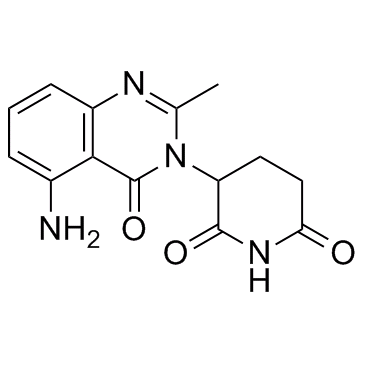1015474-32-4
| Name | cc-122 |
|---|---|
| Synonyms |
3-(5-amino-2-methyl-4-oxo-4H-quinazolin-3-yl)piperidine-2,6-dione
3-(5-amino-2-methyl-4-oxoquinazolin-3(4H)-yl)piperidine-2,6-dione rac-3-(5-amino-2-methyl-4-oxoquinazolin-3(4H)-yl)piperidine-2,6-dione 3-(5-amino-2-methyl-4-oxoquinazolin-3(4H)-yl)-piperidin-2,6-dione 3-(5-amino-2-methyl-4-oxo-4H-quinazolin-3-yl)-piperidine-2,6-dione CC122 |
| Description | CC-122 is a novel agent for DLBCL with antitumor and immunomodulatory activity.CC-122 binds CRBN and degrades Aiolos and Ikaros resulting in a mimicry of IFN signaling and apoptosis in DLBCL.In vitro: CC122 inhibits proliferation and induces apoptosis in ABC and GCB DLBCL. In DLBCL cell lines, CC122-induced degradation or short hairpin RNA-mediated knockdown of Aiolos and Ikaros correlates with increased transcription of interferon (IFN)-stimulated genes independent of IFN-α, -β, and -γ production and/or secretion and results in apoptosis in both activated B-cell (ABC) and germinal center B-cell DLBCL.[1]In vivo: Treatment of female CB-17 SCID mice with CC122 at 3 or 30 mg/kg once daily significantly decreased tumor growth in OCI-LY10 ABC-DLBCL (P = .028 and P < .001, respectively) and WSU-DLCL2 GCB-DLBCL derived xenograft models (P < .01) compared with the vehicle control. In a separate study, we assessed the ability of CC122 to promote degradation of Ikaros and Aiolos in vivo. In the 21-day efficacy study of WSU-DLCL2 xenograft transplanted mice, tumors were excised 1, 6, or 24 hours post final dosing. Aiolos and Ikaros expression was interrogated through immunohistochemistry (IHC) and was found to be decreased 64% and 30%, respectively, compared with vehicle within 1 hour of treatment, with a maximal reduction of 94% and 69%, respectively, observed at 6 hours. Aiolos and Ikaros levels partially recovered 24 hours postdosing with protein level within 20% and 34% of vehicle, respectively. The 24-hour postdose Aiolos and Ikaros expression represents the trough compound level following multiple doses of CC122. When the 1-hour time point is compared with the 24-hour postdose time point, there is a significant reduction in Aiolos but not Ikaros expression; however, at the 6-hour time point, both transcription factors are significantly different from the 24-hour time point. Taken together, these data reveal that CC122 inhibited DLBCL tumor growth in vivo and that this activity was associated with the degradation of Aiolos and Ikaros in both ABC- and GCB-DLBCL xenograft models.[1]"Mice[1]Female SCID mice (CB17/Icr-Prkdcscid, Charles River) were 8 weeks old, with body weights ranging from 15.0 to 23.2 g, on day 1 of these studies. Each SCID mouse was injected subcutaneously in the right flank with 5x106 OCI-LY10 cells (0.2 ml cell suspension). Tumors were calipered in two dimensions to monitor growth as their mean volume approached 100–150 mm3. Fourteen days (WSU-DLCL2) or twenty-one days (OCI-LY10) after tumor cell implantation, mice were sorted into treatment groups (n=10/group). Tumors were callipered twice weekly during the study. CC122 was suspended in 0.5% carboxymethyl cellulose: 0.25% Tween-80 in de-ionized water. Vehicle and CC122 were each administered via oral gavage (p.o.) once daily for twenty-eight days (qd x28). [1] |
|---|---|
| Related Catalog | |
| References |
| Molecular Formula | C14H14N4O3 |
|---|---|
| Molecular Weight | 286.28600 |
| Exact Mass | 286.10700 |
| PSA | 107.08000 |
| LogP | 1.17480 |
| Storage condition | -20℃ |


